|
"Special" Edition. It was with great consternation that I recently heard about the Coffee Borer Beetle, being identified, in the Kona growing areas, of Hawaii. And thought that a "special" edition of my ramblings, regarding this, one of the major pests, of coffee; was in order. Hawaii, until a few days ago, was thought to be one of the last major coffee growing areas, that was free of the beetles.
The female beetles attack a coffee berry, and bore a small hole in the base of the berry, and lays up to 200 (information varies on this point: whether the female lays a single large batch of eggs, or several smaller batches, in several different coffee berries) eggs in between the two developing beans. The hole can easily be see a short time later, as the sides turn almost black, presumably as the sides of the hole, dry out. It is very difficult to determine if this hole also allows other infections to enter the coffee berry, and cause secondary damage. The eggs hatch, and the larvae start feeding on the developing coffee berry, eating out the inside of the bean; in about half the infected berries, only one of the two beans, is eaten, and in the other half, both beans are eaten. When the grubs reach maturity, the females are fertilized by their sibling, males, the females fly off, and the males remain in the coffee bean, and die. I have been unable to find any information on the possibility of any method whereby the beetles can "exchange genes", by cross fertilization, between different individuals. Which would indicate that the populations, in small areas, are genetically, very similar, if not identical, and very closely related. This "life style" precludes one very effective method of biological control (as used in California, with fruit flies) of releasing vast numbers of sterile flies, into the population, and severely limiting the production of viable eggs. In ideal conditions (which appear to be very much temperature dependant) a single beetle can breed up to 4 or 5 new generations, in a single year: and with (a very conservative) 50 eggs per female, per laying; it will not take long for them to become a serious, and major pest, to coffee.
Dear Sir, It has been of great concern to me to hear that your Kona coffee industry is faced with the Coffee Borer Beetle, a pest which has the potential of destroying your whole coffee industry, unless immediate, and effective, action, is taken. I grow Jamaican Blue Mountain coffee, and we have had the Borer beetle, here, for many years; our whole industry has "learned" to live with this pest, and with the controls that are currently in place, the loss of the coffee crop is limited to about 5%, and in a very rare, really bad year, this can rise as high as 15%, and this loss, is "built into" the whole system. I have no doubt that within the whole Kona coffee industry; a "total panic" situation, exists, at the moment: doom and gloom abounding: the "authorities" will be running around in ever decreasing circles, trying to appear as though they are doing something, gesticulating, posturing, and delivering "truck loads" of verbal diarrhoea: the big processors (ever conscious of "corporate profits" being the over-riding consideration, in all things) will moan, and groan, in Biblical proportions, with wailings, gnashing of teeth, and wringing of their collectives hands, in grief: blaming anybody, and everybody, except themselves, and insisting that they should not have to shoulder any of the blame, or, more importantly, any of the costs involved, in the controlling of the problem. Leaving the growers, big and small, to "do" something, or suffer the consequences. And very little will actually, happen, at least in the short term.
In the immediate, short term, may I offer some advice:- * Check every cherry berry, before processing, and destroy all infected ones * Spray the coffee with insecticides * Clear the coffee plantations of all "dead" coffee beans * Install CBB traps * Use all the existing bio-controls, already on the Islands Personally, I have little confidence in the idea of the introduction of more "foreign species", like thrip flies, Amazon ants, etc, to control the CBB: as all too often the "controller" turns out to be a greater problem than the original, pests it was supposed to control. These controls (with proper studies having to be done, before they can (should!!) be used) can take years to even start working. Your problem, is FAR more immediate, than that!! If any of these measures really worked, they would be in use throughout the world's coffee growing areas. 1) Checking every berry before processing:- There is a very simple, and inexpensive way to do this. All cherry berries delivered to the processors (as well as all cherries that are "home" or "small scale", processed) should be floated: as simple as building a suitable sized "container" (from a swimming pool size, down to a large plastic trash can) and just pour the cherries into it, stir well, and remove all the cherries that float, or remain near (semi-floaters) the surface; these are the infected ones. They can be destroyed, by deep burying (minimum of 12 inches, and well compacted soil on top) burning, or processed into compost, which can later be sold. In Jamaica, the grower is only paid for the non-floating (sinkers) beans, which are tested, at the time of delivery, thus providing some motivation, to keep the beetles, under control.
The composter is a, covered (a heavy-duty, tarpaulin is sufficient) large pit or concrete block built structure, and when the "critical mass" is achieved (about a 15 foot, cube, but a little experimentation will give you the ideal size in your climate) the rate of anaerobic decay of the bio-mass, creates sufficient internal heat to totally sterilize the whole of the compost (as can be seen from the smoke and steam that escapes the heap). The rate of "composting" can be improved, by the addition of some layers of "starter", material: I use a few spade fulls from my "back garden" compost heap, as the starter. As the compost forms, and the volume greatly decreases, more pulping trash, and "floaters", are added, but the floaters must always be covered with the pulping trash, to prevent any beetles, escaping. The heat produced will completely kill all the beetles, in the berries, and produce some excellent saleable, compost. The compost sales, virtually making this process "self financing". For the larger scale processors, several composters would be needed, and used in rotation. 2) Spraying with insecticides:- Of the 3 pickings over our coffee season, the first picking, has the highest rate of CBB infection, as the beans have been on the bushes for the longest, and through the driest time of the year: it is most important to time the first spraying, to best treat this part of the crop: cannot really help with a specific time of year, as your coffee season, is bound to greatly differ, from ours: we try to get the timing, just after the middle of the period between the last picking ( and after the plantation clearing:- see section 3 ) and the first picking is ready to commence. We spray our coffee, twice a year, with insecticide: of the products available in Jamaica, I use Diazinon, as the "least of the evils", and it seems to have little effect on my bees. It is all important to time the spraying carefully: avoid the period 2 weeks either side of the coffee flowering, and at least 4 weeks before any coffee is picked. I also mix a fungicide in with the insecticide, and spray the coffee with this mixture (rationale, in section 4).
3) Clear the plantation:- Upon completion of the final crop picking (in Jamaica, we have 3 main "pickings" a year) wait some weeks, and go round all the coffee bushes; removing any ripe or maturing fruits that have been left on the bushes, or dropped on the ground, around the bushes (where the beetles will lie in wait, for the next season!!). Under no circumstances whatsoever should infected cherries be discarded during picking, they must be picked and put in the containers along with the good cherries, and be separated during the floating process, before being destroyed. To discard them on the ground around the coffee bushes, is an absolute guarantee of a major infection, shortly afterwards. Oh, yes, I can hear all the moaning and groaning, of how this is impossible, too expensive, etc: in fact, it is one of the MOST IMPORTANT parts of controlling the beetles, and is NOT that hard to do. We time our main annual pruning of the coffee, the application of fertilizer, and the annual inspection of EVERY bush on the plantation, with this time in the annual coffee cycle: it takes but a few moments to remove the "dead" berries from the bush, whilst pruning, and but a few more moments to pick up the dead berries from the ground, as the fertilizer is being applied, and the prunings being put around the base of the coffee bush. Collect these berries, in a sack, and incinerate (rather than slow, burn) them all. 4) CBB traps:- A very effective method of reducing the number of beetles: the traps are very easy to make, at home, from old water or soda bottles, and cost but a few cents, each. I make them by cutting off the top of the bottle (clear, plastic bottles) and inverting it back into the base of the bottle, a bit of tape around the join, to hold them together, giving a funnel to keep the beetles from escaping: the lure is put in a small plastic phial, with a pin-prick hole in the top (to slow down the rate of evaporation of the lure mixture) and is hung on a short piece of wire, inside the trap: and some water put in the bottom in which they drown. Make a couple of small slits near the bottom, to allow rain water to escape the bottle trap. Painting the traps red, or adding some red coloured bits of plastic, also attracts the beetles. The lure is a mixture of Methanol, and Ethanol (Alcohol):- Coffee berries are, like wine grapes, covered in wild yeasts, which ferment any sugars in the skin of the fruits, this alcohol vapour attracts the beetles, so, by spraying with a (broad spectrum and yeast control) fungicide, the amount of alcohol produced naturally, which attracts the beetles, is greatly reduced. The traps are ideally spaced equally around the coffee plantation, at 10 per acre: with some extra traps on the upwind side (the CBB is not a great long distance flier, and will be carried along by the wind) and along the side of the plantation, where there is the greatest concentration, of other coffee bushes.
5) Local bio-controls:- Put up bird nesting boxes, to encourage all the small birds, who will consume innumerable beetles, every day! These simple measures reduce my borer infection rate, to between 1 and 2% of the total crop, as well as supplying myself with excellent compost, re-cycling old soda bottles, improving the look of the platation, surrounded with bright red flowers: and hosts of small birds. I can do nothing about the beetles that arrive here, from neighbouring plantations, where these measures are not fully undertaken, except put out the traps for them, and I will never be totally free of them. The small growers around here (some with as few as a dozen coffee bushes in their "back yards") will never take this problem seriously, until the infection rate starts to reach 25% plus, of their coffee, and starts to hit them in their pockets! As it is at the moment, they all just accept the small (average 5% overall) losses, which is the "norm", and taken into all calculations. If I can offer any further help or advice, please do not hesitate to contact me. Please feel free to pass this message on to any relevant, concerned, or interested parties, and edit it in any way you think would make it more relevant to your, Hawaiian situation. Best Wishes Robin Plough, friend of www.coffee4dummies.com For questions about JBM, mail to: Этот e-mail адрес защищен от спам-ботов, для его просмотра у Вас должен быть включен Javascript |
SPECIAL: Coffee borer beetle in Hawaii
SPECIAL: Coffee borer beetle in Hawaii


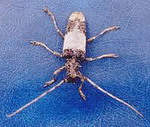 The beetle itself is tiny, you can get some idea if its size, when you consider that a single coffee bean, can "house and feed" several dozen of them.
The beetle itself is tiny, you can get some idea if its size, when you consider that a single coffee bean, can "house and feed" several dozen of them.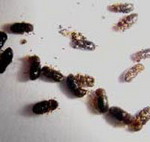 From the reports that I am getting from Hawaii, it is a "panic" situation, with no one knowing what to do: I have written to several people in Kona, with my thoughts on their problem, and the basics of the methods we use in Jamaica, to control this pest: I think this letter explains how we control the beetles on our coffee, and I have attached a copy, for you to read.
From the reports that I am getting from Hawaii, it is a "panic" situation, with no one knowing what to do: I have written to several people in Kona, with my thoughts on their problem, and the basics of the methods we use in Jamaica, to control this pest: I think this letter explains how we control the beetles on our coffee, and I have attached a copy, for you to read.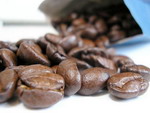 Then I read that the big processors are prepared to "sacrifice" a derisory, 0.5% [half a pound out of every 100 pound sack] of the cherries delivered to them for "sample testing":
Then I read that the big processors are prepared to "sacrifice" a derisory, 0.5% [half a pound out of every 100 pound sack] of the cherries delivered to them for "sample testing": 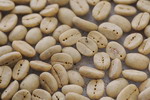 The composting process, is very different to the usual "back garden" compost heap; and requires large amounts of coffee trash, to be effective: the infected cherries are thrown into the centre of the composter, in layers, between layers of the pulping trash; which should be drained, but not dried, as the composter works best when "damp" rather than "wet". This composting process takes only a couple of weeks, unlike the many months for the "back garden" compost heap.
The composting process, is very different to the usual "back garden" compost heap; and requires large amounts of coffee trash, to be effective: the infected cherries are thrown into the centre of the composter, in layers, between layers of the pulping trash; which should be drained, but not dried, as the composter works best when "damp" rather than "wet". This composting process takes only a couple of weeks, unlike the many months for the "back garden" compost heap. In Jamaica, we have our "Regulator", the Coffee Industry Board (
In Jamaica, we have our "Regulator", the Coffee Industry Board (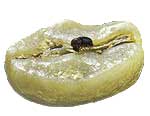 The planting of "decorative" flowers along the edges of the plantation, with bright red flowers ( our native Red Ginger plants, perform well in this respect ) and a few extra traps around them, will attract the flying beetles, and lure them towards the traps: as well as making the whole place look more attractive, with all the flowers.
The planting of "decorative" flowers along the edges of the plantation, with bright red flowers ( our native Red Ginger plants, perform well in this respect ) and a few extra traps around them, will attract the flying beetles, and lure them towards the traps: as well as making the whole place look more attractive, with all the flowers.


